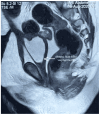Persistent Urogenital Sinus Leading to Hydrometrocolpos in a Female Child With Features of McKusick-Kaufman Syndrome
- PMID: 38978907
- PMCID: PMC11230620
- DOI: 10.7759/cureus.61957
Persistent Urogenital Sinus Leading to Hydrometrocolpos in a Female Child With Features of McKusick-Kaufman Syndrome
Abstract
Persistent urogenital sinus (PUGS) presents as a solitary abnormality or is in association with syndromes, such as congenital adrenal hyperplasia (CAH), VACTERL association (common abbreviation for vertebral defects, anal atresia, cardiac defects, tracheoesophageal fistula, renal anomalies, and limb abnormalities), Bardet-Beidl syndrome, McKusick-Kaufman syndrome (MKS), and Townes-Brocks syndrome, to name a few. Those affected usually have overlapping phenotypic features of two or more syndromes. Because such children may grow up to be intellectually challenged with multiple other anomalies including gonadal hyperplasia, congenital heart defects, and sensorineural hearing loss, antenatal diagnosis becomes important. Moreover, those who survive into childhood may need a holistic approach to improve their quality of life. This is a rare case of an eight-year-old female child who is a postnatally diagnosed case of congenital heart disease, urogenital sinus with polydactyly, and bilateral hydroureteronephrosis at birth and who is now showing features of multiple overlapping syndromes.
Keywords: foot polydactyly; genetic syndromes; hydroureteronephrosis; overlapping syndromes; urogenital sinus.
Copyright © 2024, Thorat et al.
Conflict of interest statement
Human subjects: Consent was obtained or waived by all participants in this study. Conflicts of interest: In compliance with the ICMJE uniform disclosure form, all authors declare the following: Payment/services info: All authors have declared that no financial support was received from any organization for the submitted work. Financial relationships: All authors have declared that they have no financial relationships at present or within the previous three years with any organizations that might have an interest in the submitted work. Other relationships: All authors have declared that there are no other relationships or activities that could appear to have influenced the submitted work.
Figures




References
-
- Persistent urogenital sinus: diagnostic imaging for clinical management. What does the radiologist need to know? Valentini AL, Giuliani M, Gui B, et al. Am J Perinatol. 2016;33:425–432. - PubMed
-
- Persistent urogenital sinus. Singh S, Singh P, Singh RJ. J Anat Soc India. 2010;59:242–244.
-
- Congenital adrenal hyperplasia--a continuum of disorders. Hughes IA. Lancet. 1998;352:752–754. - PubMed
-
- The etiology of VACTERL association: current knowledge and hypotheses. Solomon BD. Am J Med Genet C Semin Med Genet. 2018;178:440–446. - PubMed
-
- Kohlhase J. GeneReviews. Seattle, WA: University of Washington; 1993. Townes-Brocks syndrome.
Publication types
LinkOut - more resources
Full Text Sources
